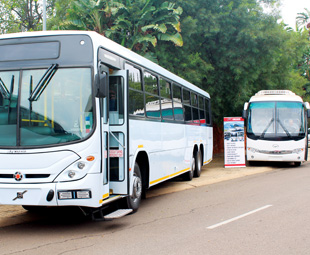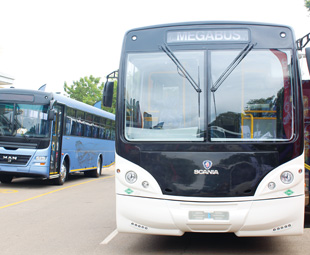Positive news?

Key issues at the 2016 Southern African Bus Operators Association (Saboa) conference included a turnaround plan for the contract bus industry and numerous amendment bills. GAVIN MYERS attended
Before you ask – no, the minister of transport did not make it to the conference, yet again. She did, however, deploy the Director General of Transport, Pule Godfrey Selepe, to deliver her key note address on her behalf.
Selepe was joined by his deputy, Mathabatha Mokonyama – who addressed the conference on the national land transport strategic framework, with specific reference to the Department of Transport’s (DoT’s) turnaround plan for the contract bus industry. So, two more senior government representatives one could not (probably) have hoped for …
Some of the most pertinent points to be raised in the keynote address were:
 • Eighty percent of the population is totally dependant on public transport and the economic impact of the 25 000 buses in the industry can be summarised as: They have an estimated replacement value of R25 billion, direct employment is provided to 30 600 people, and 860-million passenger trips are undertaken per annum.
• Eighty percent of the population is totally dependant on public transport and the economic impact of the 25 000 buses in the industry can be summarised as: They have an estimated replacement value of R25 billion, direct employment is provided to 30 600 people, and 860-million passenger trips are undertaken per annum.
• Government’s subsidy level for rail and road public transport is comparably high – at around 60 percent of the economic cost of rendering the service – compared to a “rarely exceeded” 30 percent in other countries.
“We are mindful of the shortfalls in subsidies to bus operators in terms of their contracts and are having discussions with treasury about filling that gap. We are not happy about the situation. We have the best chance in decades to forge a new future,” Selepe quoted the minister as saying.
• A strong foundation for a successful bus industry and IRPTNs has been established with the implementation of the public transport turnaround strategy …
“The shared vision for the future should be a bus industry where service excellence is the norm. While we are on the right track, we are still a long way from our destination. No simple solutions exist for these challenges, and we can only do this through partnerships,” Selepe added.
 It was, however, undoubtedly, Mokonyama’s presentation that had the most “meat on the bone” – substantiating the minister’s comments – as well as demonstrating an epiphany of sorts.
It was, however, undoubtedly, Mokonyama’s presentation that had the most “meat on the bone” – substantiating the minister’s comments – as well as demonstrating an epiphany of sorts.
“Government is aware of the challenges associated with the current way of doing things; among them is that operators have been on month-to-month contracts since 1997, or so,” he began.
“The parliamentary process has been finalised for the public transport operating grant (PTOG) allocation for 2015/16. We have an additional R250 million a year (cut from R500 million), so we are still getting an increase, whereas all other budgets in government have been cut. The PTOG increase is slightly above the Consumer Price Index (CPI).”
Mokonyama made it clear that provinces have been advised not to use the money to expand, but rather to deal with the challenges in order to improve the performance of current contracts. Herein came the revelation …
“We have done a rough assessment, and we should be the first to concede that bus rapid transit (BRT) systems are expensive! If you think construction is expensive, operations are worse! The cost to government and, therefore, to the user, is ridiculous. It doesn’t work in the South African context and will never work if you look at land-use patterns. We do not have the dense corridors to justify those kinds of systems,” he admitted.
“We are insisting the municipalities should do proper public transport plans, which form part of integrated public transport networks (IPTNs). This focus on BRTs should be relooked at in terms of a revenue approach. We need longer-term contracts for sustainability.”
 What are the implications of this in terms of practical implementation? The one-size-fits-all approach is out – “It doesn’t work in any sector or industry,” Mokonyama noted.
What are the implications of this in terms of practical implementation? The one-size-fits-all approach is out – “It doesn’t work in any sector or industry,” Mokonyama noted.
In its place are groupings of main metros, emerging metros, medium cities, rural centres and deep rural areas, which will each require unique interventions: mixed traffic on some BRT trunks to ease congestion in big metros, for example.
Mokonyama explained: “Interim contracts should not be month to month, but a minimum of three years to create sustainability. In the plan there will be a mixture of tenders and negotiated contracts, of up to 12 years. We want to believe that it’ll go a long way to improving the transport system. We are finalising this, and once we are done it’ll be made available to the public for comment.”
On the point of scholar transport, Mokonyama noted: “While commuter services are supported by government to the tune of R4,9 billion (now up by aforementioned R250 million), scholar transport has been supported by about R2 billion per year nationwide.
“We have concluded the National Learner Transport Policy, and whoever implements scholar transport must do so in terms of the policy. The premiers allocate functions the way they want to, because the constitution allows them to, but if provinces are not managing scholar transport according to the new policy, they must be taken to task,” he insisted.
“It is important to remember that: we are moderating and going more slowly with BRTs; we want to see the re-emergence of the conventional bus service – this needs to dominate as these services are cheaper and more ideal for South Africa; and we must have mixed fleets,” he reiterated, before issuing a stern caution …
“If this plan is done properly, it’ll cost us about R3 billion per year including rail – which is not that much. The economic situation is not good, however, and all of this is dependant on money. So, if there are insufficient funds, this plan to rescue the South African commuting public will come to zero.”
 Of course, there were many more notable discussions at Saboa 2016, such as the amendments to the Administrative Adjudication of Road Traffic Offences (AARTO) Act, and how this will affect transport operators. FOCUS will bring you some comment from these in forthcoming issues.
Of course, there were many more notable discussions at Saboa 2016, such as the amendments to the Administrative Adjudication of Road Traffic Offences (AARTO) Act, and how this will affect transport operators. FOCUS will bring you some comment from these in forthcoming issues.
In the interim visit the Saboa website for all the presentations from this year’s conference.
They said it …
The presentation on the turnaround plan is positive for the whole bus industry. It’s encouraging to hear about shifting funds to the PTOG, which has been a contentious issue for some time.
– Franco Pisapia, Putco
We rarely hear positive news from the department … We get a lot of confusing messages from different spheres of government. If you can capacitate those spheres so that they talk about what you’re telling us today, we will make it work more quickly.
– Nora Fakude, Buscor
The rate that we know is economical is more than the Division of Revenue Act says it can give. That is setting up the smaller operator for failure.
– from the floor
It’s the first time in ten or 15 years that we share a common understanding of these problems and how to solve them. There are still some frustrations: we need improved public infrastructure, road conditions, law enforcement (especially with taxi problems), and the management of operating licences is a huge issue.
– Fracois Meyer, Golden Arrow Bus Service (GABS)
This is a way forward, but will the negotiated contracts – after the process is complete – be entered into with existing operators?
– Nick de Beer, North West Transport
It’s good that you’ll be looking to implement services that will suit the different areas of operation, not a one-size-fits-all approach, or reinventing the wheel.
– Nora Fakude, Buscor
The promise of money has to be there if we’ve done what we were asked to do to make the process viable and sustainable for the 12-year period.
– from the floor
In some provinces the scholar transport subsidy resides with the department of education, and in other it’s with the DoT. Why? The operators are not treated equally.
– from the floor
The lack of progress has also inhibited the transformation process. There are many operators who are keen to move ahead and provide a better quality service with proper controls in place.
– Franco Pisapia, Putco
We’re still concerned with the sustainability of BRT services. We are converting conventional bus services – which are economical and efficient to operate – into BRT, and are really worried that down the road government will start cutting back. Then we’ll be without any type of efficient service.
– Fracois Meyer, GABS
If small bus operators are not recapped, we cannot qualify for new tenders, because our buses are much older than the required five years – 75 percent of us are using busses older than 20 years.
– from the floor
There are no plans to recapitalise small buses.
– Mathabatha Mokonyama, DoT
Published by
Focus on Transport
focusmagsa




